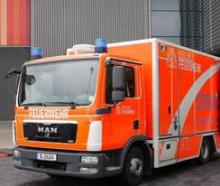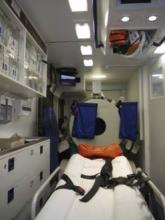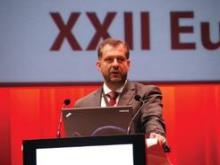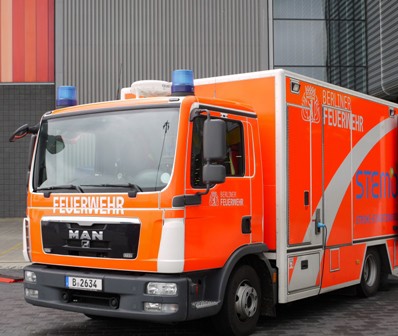User login
LONDON – The use of a specialized ambulance enabled more patients with acute ischemic stroke to receive thrombolytic therapy than if standard emergency response vehicles were used in a randomized, controlled trial.
Preliminary results of the PHANTOM-S study also showed that stroke patients were given intravenous tissue plasminogen activator (TPA) 25 minutes sooner in the weeks when the stroke emergency mobile (STEMO) unit was in service, compared with the weeks when it was not.
"We have shown that the STEMO concept can be integrated into a metropolitan emergency medical system," said Dr. Heinrich Audebert, the head of the STEMO project, which is based at Charité-Universitätsmedizin Berlin.
Speaking at the annual European Stroke Conference, Dr. Audebert added that the approach was "safe and superior to regular [emergency] care regarding the quality of care, the proportion of patients receiving TPA, and the time to treatment."
There is further potential to use the mobile stroke unit in the treatment of patients with intracranial hemorrhage and to triage for interventional treatment, he suggested.
Speed is key for stroke thrombolysis
The rationale for the STEMO project, which is based in Berlin, is that thrombolysis is an effective treatment for some patients with acute ischemic stroke. Thrombolytic treatment needs to be administered within a short time frame, Dr. Audebert said, and past a critical time point of 4.5 hours, TPA is no longer given in Germany. The latest guidelines issued jointly by the American Heart Association and the American Stroke Association recommend that TPA be given within 3 hours of stroke onset (Stroke 2013;44:870-947).
However, there are several difficulties in administering TPA in the first few hours after an acute stroke, including determining if the patient is a suitable candidate for thrombolytic therapy, identifying the exact time at which the ischemic injury actually occurred, and transporting the patient quickly enough to a hospital for such treatment.
The STEMO project aims to improve stroke patients’ clinical care by enabling TPA to be administered before the patient arrives at hospital. To achieve this, an ambulance owned by the Berlin Fire Department was adapted to accommodate an onboard computed tomography (CT) scanner, point-of-care laboratory, and teleradiography system. This specialized mobile stroke unit is staffed by a paramedic, a neurologist with emergency medicine training, and a radiographer.
The PHANTOM-S study
The PHANTOM-S (Pre-Hospital Acute Neurological Treatment and Optimization of Medical Care in Stroke) study follows on from a 3-month pilot study that provided proof-of-concept for the use of the STEMO unit in 23 hospitals in the Berlin area (Neurology 2013;80:163-8). The larger, randomized study involved 28 hospitals in the region, which provide emergency services to about 1.3 million people.
During the PHANTOM-S study, the STEMO vehicle was in service alternating weeks. The weeks when the specialized ambulance was not deployed were used as the control period. A stroke identification algorithm previously developed by the team (Stroke 2012;43:776-81) was used to decide whether to deploy the STEMO unit to an emergency call.
Over a 21-month study period, 7,098 suspected stroke patients were enrolled and 6,573 were transported to the nearest adequately equipped hospital. Around half were seen in the weeks that the STEMO vehicle was in service.
During the in-service weeks, the STEMO vehicle was deployed a total of 2,027 times out of 3,668 calls. There were a total of 1,804 patients seen by the unit with enough data for study evaluation. Of these, 201 of 614 (33%) patients with acute ischemic stroke were given TPA before reaching the hospital.
A significantly higher percentage of stroke patients received prehospital thrombolysis when the STEMO unit was in service, at 29%, compared with 21% for the control weeks (P less than .001).
The percentage of patients subsequently transported to a hospital with a dedicated stroke unit was also higher during the weeks when the STEMO unit was in service than during the control weeks (93% vs. 87%; P less than .01).
Quicker time to TPA
The mean time from "deployment to needle," said Dr. Audebert, was 77 minutes for the weeks when the specialized ambulance was not in use, compared with 62 minutes when it was (P less than .01). This was reduced to 52 minutes if the STEMO unit was actually deployed (P less than .01 versus control weeks), and dropped to 48 minutes for patients who were actually given TPA in the mobile unit.
In-hospital death rates in confirmed stroke cases were 4.4% for the STEMO in-service weeks (3.8% if the unit was actually deployed) and 4.5% for control weeks.
In TPA-treated patients, there was a nonsignificant trend toward fewer patients having intracranial hemorrhage if TPA was delivered in the STEMO unit, at 3.5%, compared with the overall rates during STEMO-serviced weeks (4.8%) and control weeks (6.0%).
"The current response time is about 16 minutes," coinvestigator Dr. Martin Ebinger, also of Charité-Universitätsmedizin Berlin, commented at a press briefing.
"Sometimes there were multiple, simultaneous calls," he said, noting that, at the current time, there is only one STEMO vehicle. If there were two mobile stroke units, then of course more people in the catchment area could be reached, and the response time could maybe even be halved to 8 minutes.
"We really need a very good, independent cost-effectiveness analysis," Dr. Ebinger conceded. Discussions with patient insurance groups and politicians have been started to determine how best to conduct such an analysis.
Dr. Michael Hennerici, professor of neurology at the University of Heidelberg in Germany, commented at the press briefing that giving thrombolysis to patients who have had a stroke is perhaps more complex than giving it to those who have had a heart attack. There are many different types of stroke, and only a selected population may require thrombolysis, he observed.
Dr. Martin Brown, professor of stroke medicine at University College London, also gave his thoughts on the data in an interview. "It certainly makes sense to get the treatment to patients as quickly as possible, but we need a CT scan of every patient before we give the treatment," he said.
"The real question is, however, ‘Is it more efficient to work on getting the patient to hospital as quickly as possible, or if we should be working on this model and trying to get money for more expensive ambulances?" Dr. Brown added.
"What we really need to know is what difference an extra 25 minutes means in terms of the number of patients that gain benefit. If it is only a small proportion, it might not be cost-effective," Dr. Brown said.
The STEMO project is a collaboration between Charité-Universitätsmedizin Berlin, the Berlin Fire Department, Brahms GmbH, and MEYTEC GmbH. It is cofunded by Technology Foundation Berlin and the European Fund for Regional Development. Dr. Hennerici and Dr. Brown were not involved in the study. Dr. Ebinger had no conflicts of interest. Dr. Audebert has received honoraria from Bayer, Bristol-Myers Squibb, and other companies.
LONDON – The use of a specialized ambulance enabled more patients with acute ischemic stroke to receive thrombolytic therapy than if standard emergency response vehicles were used in a randomized, controlled trial.
Preliminary results of the PHANTOM-S study also showed that stroke patients were given intravenous tissue plasminogen activator (TPA) 25 minutes sooner in the weeks when the stroke emergency mobile (STEMO) unit was in service, compared with the weeks when it was not.
"We have shown that the STEMO concept can be integrated into a metropolitan emergency medical system," said Dr. Heinrich Audebert, the head of the STEMO project, which is based at Charité-Universitätsmedizin Berlin.
Speaking at the annual European Stroke Conference, Dr. Audebert added that the approach was "safe and superior to regular [emergency] care regarding the quality of care, the proportion of patients receiving TPA, and the time to treatment."
There is further potential to use the mobile stroke unit in the treatment of patients with intracranial hemorrhage and to triage for interventional treatment, he suggested.
Speed is key for stroke thrombolysis
The rationale for the STEMO project, which is based in Berlin, is that thrombolysis is an effective treatment for some patients with acute ischemic stroke. Thrombolytic treatment needs to be administered within a short time frame, Dr. Audebert said, and past a critical time point of 4.5 hours, TPA is no longer given in Germany. The latest guidelines issued jointly by the American Heart Association and the American Stroke Association recommend that TPA be given within 3 hours of stroke onset (Stroke 2013;44:870-947).
However, there are several difficulties in administering TPA in the first few hours after an acute stroke, including determining if the patient is a suitable candidate for thrombolytic therapy, identifying the exact time at which the ischemic injury actually occurred, and transporting the patient quickly enough to a hospital for such treatment.
The STEMO project aims to improve stroke patients’ clinical care by enabling TPA to be administered before the patient arrives at hospital. To achieve this, an ambulance owned by the Berlin Fire Department was adapted to accommodate an onboard computed tomography (CT) scanner, point-of-care laboratory, and teleradiography system. This specialized mobile stroke unit is staffed by a paramedic, a neurologist with emergency medicine training, and a radiographer.
The PHANTOM-S study
The PHANTOM-S (Pre-Hospital Acute Neurological Treatment and Optimization of Medical Care in Stroke) study follows on from a 3-month pilot study that provided proof-of-concept for the use of the STEMO unit in 23 hospitals in the Berlin area (Neurology 2013;80:163-8). The larger, randomized study involved 28 hospitals in the region, which provide emergency services to about 1.3 million people.
During the PHANTOM-S study, the STEMO vehicle was in service alternating weeks. The weeks when the specialized ambulance was not deployed were used as the control period. A stroke identification algorithm previously developed by the team (Stroke 2012;43:776-81) was used to decide whether to deploy the STEMO unit to an emergency call.
Over a 21-month study period, 7,098 suspected stroke patients were enrolled and 6,573 were transported to the nearest adequately equipped hospital. Around half were seen in the weeks that the STEMO vehicle was in service.
During the in-service weeks, the STEMO vehicle was deployed a total of 2,027 times out of 3,668 calls. There were a total of 1,804 patients seen by the unit with enough data for study evaluation. Of these, 201 of 614 (33%) patients with acute ischemic stroke were given TPA before reaching the hospital.
A significantly higher percentage of stroke patients received prehospital thrombolysis when the STEMO unit was in service, at 29%, compared with 21% for the control weeks (P less than .001).
The percentage of patients subsequently transported to a hospital with a dedicated stroke unit was also higher during the weeks when the STEMO unit was in service than during the control weeks (93% vs. 87%; P less than .01).
Quicker time to TPA
The mean time from "deployment to needle," said Dr. Audebert, was 77 minutes for the weeks when the specialized ambulance was not in use, compared with 62 minutes when it was (P less than .01). This was reduced to 52 minutes if the STEMO unit was actually deployed (P less than .01 versus control weeks), and dropped to 48 minutes for patients who were actually given TPA in the mobile unit.
In-hospital death rates in confirmed stroke cases were 4.4% for the STEMO in-service weeks (3.8% if the unit was actually deployed) and 4.5% for control weeks.
In TPA-treated patients, there was a nonsignificant trend toward fewer patients having intracranial hemorrhage if TPA was delivered in the STEMO unit, at 3.5%, compared with the overall rates during STEMO-serviced weeks (4.8%) and control weeks (6.0%).
"The current response time is about 16 minutes," coinvestigator Dr. Martin Ebinger, also of Charité-Universitätsmedizin Berlin, commented at a press briefing.
"Sometimes there were multiple, simultaneous calls," he said, noting that, at the current time, there is only one STEMO vehicle. If there were two mobile stroke units, then of course more people in the catchment area could be reached, and the response time could maybe even be halved to 8 minutes.
"We really need a very good, independent cost-effectiveness analysis," Dr. Ebinger conceded. Discussions with patient insurance groups and politicians have been started to determine how best to conduct such an analysis.
Dr. Michael Hennerici, professor of neurology at the University of Heidelberg in Germany, commented at the press briefing that giving thrombolysis to patients who have had a stroke is perhaps more complex than giving it to those who have had a heart attack. There are many different types of stroke, and only a selected population may require thrombolysis, he observed.
Dr. Martin Brown, professor of stroke medicine at University College London, also gave his thoughts on the data in an interview. "It certainly makes sense to get the treatment to patients as quickly as possible, but we need a CT scan of every patient before we give the treatment," he said.
"The real question is, however, ‘Is it more efficient to work on getting the patient to hospital as quickly as possible, or if we should be working on this model and trying to get money for more expensive ambulances?" Dr. Brown added.
"What we really need to know is what difference an extra 25 minutes means in terms of the number of patients that gain benefit. If it is only a small proportion, it might not be cost-effective," Dr. Brown said.
The STEMO project is a collaboration between Charité-Universitätsmedizin Berlin, the Berlin Fire Department, Brahms GmbH, and MEYTEC GmbH. It is cofunded by Technology Foundation Berlin and the European Fund for Regional Development. Dr. Hennerici and Dr. Brown were not involved in the study. Dr. Ebinger had no conflicts of interest. Dr. Audebert has received honoraria from Bayer, Bristol-Myers Squibb, and other companies.
LONDON – The use of a specialized ambulance enabled more patients with acute ischemic stroke to receive thrombolytic therapy than if standard emergency response vehicles were used in a randomized, controlled trial.
Preliminary results of the PHANTOM-S study also showed that stroke patients were given intravenous tissue plasminogen activator (TPA) 25 minutes sooner in the weeks when the stroke emergency mobile (STEMO) unit was in service, compared with the weeks when it was not.
"We have shown that the STEMO concept can be integrated into a metropolitan emergency medical system," said Dr. Heinrich Audebert, the head of the STEMO project, which is based at Charité-Universitätsmedizin Berlin.
Speaking at the annual European Stroke Conference, Dr. Audebert added that the approach was "safe and superior to regular [emergency] care regarding the quality of care, the proportion of patients receiving TPA, and the time to treatment."
There is further potential to use the mobile stroke unit in the treatment of patients with intracranial hemorrhage and to triage for interventional treatment, he suggested.
Speed is key for stroke thrombolysis
The rationale for the STEMO project, which is based in Berlin, is that thrombolysis is an effective treatment for some patients with acute ischemic stroke. Thrombolytic treatment needs to be administered within a short time frame, Dr. Audebert said, and past a critical time point of 4.5 hours, TPA is no longer given in Germany. The latest guidelines issued jointly by the American Heart Association and the American Stroke Association recommend that TPA be given within 3 hours of stroke onset (Stroke 2013;44:870-947).
However, there are several difficulties in administering TPA in the first few hours after an acute stroke, including determining if the patient is a suitable candidate for thrombolytic therapy, identifying the exact time at which the ischemic injury actually occurred, and transporting the patient quickly enough to a hospital for such treatment.
The STEMO project aims to improve stroke patients’ clinical care by enabling TPA to be administered before the patient arrives at hospital. To achieve this, an ambulance owned by the Berlin Fire Department was adapted to accommodate an onboard computed tomography (CT) scanner, point-of-care laboratory, and teleradiography system. This specialized mobile stroke unit is staffed by a paramedic, a neurologist with emergency medicine training, and a radiographer.
The PHANTOM-S study
The PHANTOM-S (Pre-Hospital Acute Neurological Treatment and Optimization of Medical Care in Stroke) study follows on from a 3-month pilot study that provided proof-of-concept for the use of the STEMO unit in 23 hospitals in the Berlin area (Neurology 2013;80:163-8). The larger, randomized study involved 28 hospitals in the region, which provide emergency services to about 1.3 million people.
During the PHANTOM-S study, the STEMO vehicle was in service alternating weeks. The weeks when the specialized ambulance was not deployed were used as the control period. A stroke identification algorithm previously developed by the team (Stroke 2012;43:776-81) was used to decide whether to deploy the STEMO unit to an emergency call.
Over a 21-month study period, 7,098 suspected stroke patients were enrolled and 6,573 were transported to the nearest adequately equipped hospital. Around half were seen in the weeks that the STEMO vehicle was in service.
During the in-service weeks, the STEMO vehicle was deployed a total of 2,027 times out of 3,668 calls. There were a total of 1,804 patients seen by the unit with enough data for study evaluation. Of these, 201 of 614 (33%) patients with acute ischemic stroke were given TPA before reaching the hospital.
A significantly higher percentage of stroke patients received prehospital thrombolysis when the STEMO unit was in service, at 29%, compared with 21% for the control weeks (P less than .001).
The percentage of patients subsequently transported to a hospital with a dedicated stroke unit was also higher during the weeks when the STEMO unit was in service than during the control weeks (93% vs. 87%; P less than .01).
Quicker time to TPA
The mean time from "deployment to needle," said Dr. Audebert, was 77 minutes for the weeks when the specialized ambulance was not in use, compared with 62 minutes when it was (P less than .01). This was reduced to 52 minutes if the STEMO unit was actually deployed (P less than .01 versus control weeks), and dropped to 48 minutes for patients who were actually given TPA in the mobile unit.
In-hospital death rates in confirmed stroke cases were 4.4% for the STEMO in-service weeks (3.8% if the unit was actually deployed) and 4.5% for control weeks.
In TPA-treated patients, there was a nonsignificant trend toward fewer patients having intracranial hemorrhage if TPA was delivered in the STEMO unit, at 3.5%, compared with the overall rates during STEMO-serviced weeks (4.8%) and control weeks (6.0%).
"The current response time is about 16 minutes," coinvestigator Dr. Martin Ebinger, also of Charité-Universitätsmedizin Berlin, commented at a press briefing.
"Sometimes there were multiple, simultaneous calls," he said, noting that, at the current time, there is only one STEMO vehicle. If there were two mobile stroke units, then of course more people in the catchment area could be reached, and the response time could maybe even be halved to 8 minutes.
"We really need a very good, independent cost-effectiveness analysis," Dr. Ebinger conceded. Discussions with patient insurance groups and politicians have been started to determine how best to conduct such an analysis.
Dr. Michael Hennerici, professor of neurology at the University of Heidelberg in Germany, commented at the press briefing that giving thrombolysis to patients who have had a stroke is perhaps more complex than giving it to those who have had a heart attack. There are many different types of stroke, and only a selected population may require thrombolysis, he observed.
Dr. Martin Brown, professor of stroke medicine at University College London, also gave his thoughts on the data in an interview. "It certainly makes sense to get the treatment to patients as quickly as possible, but we need a CT scan of every patient before we give the treatment," he said.
"The real question is, however, ‘Is it more efficient to work on getting the patient to hospital as quickly as possible, or if we should be working on this model and trying to get money for more expensive ambulances?" Dr. Brown added.
"What we really need to know is what difference an extra 25 minutes means in terms of the number of patients that gain benefit. If it is only a small proportion, it might not be cost-effective," Dr. Brown said.
The STEMO project is a collaboration between Charité-Universitätsmedizin Berlin, the Berlin Fire Department, Brahms GmbH, and MEYTEC GmbH. It is cofunded by Technology Foundation Berlin and the European Fund for Regional Development. Dr. Hennerici and Dr. Brown were not involved in the study. Dr. Ebinger had no conflicts of interest. Dr. Audebert has received honoraria from Bayer, Bristol-Myers Squibb, and other companies.
AT THE EUROPEAN STROKE CONFERENCE
Major finding: The time from an emergency call to appropriate TPA initiation was reduced by 25 minutes through the use of a stroke emergency mobile unit.
Data source: PHANTOM-S, a randomized controlled trial involving more than 7,000 stroke patients treated in a specially equipped ambulance or via normal emergency services.
Disclosures: The STEMO project is a collaboration between Charité-Universitätsmedizin Berlin, the Berlin Fire Department, Brahms GmbH, and MEYTEC GmbH. It is cofunded by Technology Foundation Berlin and the European Fund for Regional Development. Dr. Hennerici and Dr. Brown were not involved in the study. Dr. Ebinger had no conflicts of interest. Dr. Audebert has received honoraria from Bayer, Bristol-Myers Squibb, and other companies.




